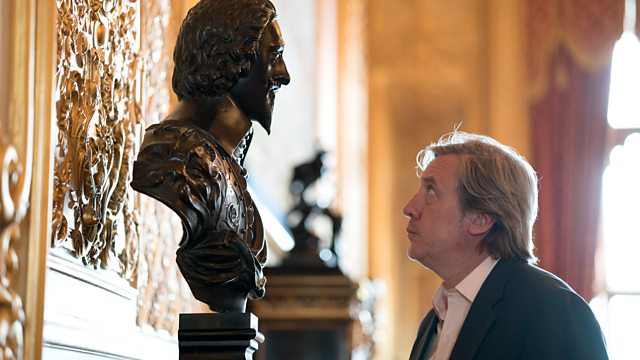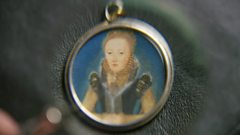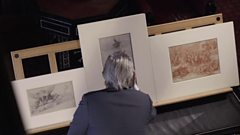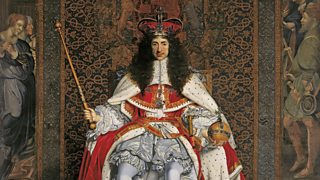
Dangerous Magic
Andrew Graham-Dixon shows how Henry VIII and Charles I, the two great founders of the Royal Collection, projected their power and magnificence through art.
In a major four-part series, Andrew Graham-Dixon explores the history of the Royal Collection, the dazzling collection of art and decorative objects owned by the Queen. Containing over a million items, this is one of the largest art collections in the world - its masterpieces by Van Dyck, Holbein, Leonardo da Vinci, Vermeer and Canaletto line the walls of Windsor Castle, Hampton Court and many other palaces, museums and institutions around Britain.
Andrew argues that on the surface, the Royal Collection projects permanence, but within these objects are stories of calamity, artistic passions and reinvention. Their collecting shows how these kings and queens wielded power, but it also reveals their personalities - it's through their individual passions that we see them at their most human.
In this first episode, Andrew marvels at the works acquired by the great founders of the modern Royal Collection - Henry VIII and Charles I. Henry VIII deployed the most essential rule of royal collecting, that great art projects great power. Andrew decodes The Story of Abraham series of tapestries in Hampton Court Palace's Great Hall, explaining how these luxury artworks contain a simple message for his terrified court - obedience.
But Henry also presided over the first great age of the portrait in England; his painter, Hans Holbein the Younger, was a magician who stopped time, preserving the faces of Henry's court forever. Andrew visits the Royal Collection's set of over 80 Holbein drawings in Windsor Castle's print room to see how the artist helped the English to understand themselves in a new way.
Henry VIII tried to overwhelm with magnificence, but for Charles I art was a way to compete with other kings through taste. He was our first connoisseur-king and the greatest royal collector in British history. It was a fateful journey to Spain to win the hand of a Spanish princess that opened Charles's eyes to the works of Titian and Raphael. But his transformation into a world-class collector was sealed with the wholesale purchase of the enormous art collection of the impoverished Mantuan court. The greatest of the Mantuan treasures were Mantegna's nine-picture series of The Triumphs of Caesar that Charles installed at Hampton Court. They are themselves a visual depiction of how power - and art - passes from the weak to the strong. Charles was top dog for now - but for how long?
Andrew explores how Charles I's Royal Collection introduced a new artistic language to British art. The sensuality of Titian and the epic canvases of Tintoretto, still in the Royal Collection today, were a revelation for a country whose visual culture had been obliterated by the Reformation. And we see how Sir Anthony van Dyck created a glamorous new style for the king that could have served as a new beginning for British art. But this was a future that would never happen - the English Civil War and Charles I's execution put an end to this first great age of royal collecting, with the king's artworks sold in 'the most extravagant royal car-boot sale in history'.
Last on
More episodes
Previous
You are at the first episode
See all episodes from Art, Passion & Power: The Story of the Royal Collection
Clips
-
![]()
Royal armour
Duration: 02:07
-
![]()
Elizabethan miniatures
Duration: 02:15
-
![]()
Faces from Henry VIII's court
Duration: 03:00
-
![]()
Web exclusive: Michelangelo's drawings
Duration: 02:58
Music Played
-
![]()
They Might Be Giants
Man, It's So Loud In Here
Credits
| Role | Contributor |
|---|---|
| Presenter | Andrew Graham-Dixon |
| Executive Producer | Judith Winnan |
| Series Producer | Sebastian Barfield |
| Expert | Vanessa Remington |
| Expert | Simon Metcalf |
| Expert | Desmond Shawe-Taylor |
| Expert | Nicola Christie |
| Editor | Stuart Davies |
| Production Manager | J Ruth Stevens |
| Production Manager | Kate Horvath |
Broadcasts
- Tue 16 Jan 2018 21:00
- Mon 22 Jan 2018 02:40
- Tue 9 Jul 2019 22:00
- Wed 29 Jan 2020 23:00
- Fri 17 Jul 2020 00:00
Featured in...
![]()
Art on ±«Óãtv Four
The stories behind iconic works of art.
![]()
Art, Passion & Power
In a major new series, Andrew Graham-Dixon explores the history of the Royal Collection.
![]()
Art, Passion & Power
Andrew Graham-Dixon explores the history of the Royal Collection.
Charles I: King of the collectors
The show reuniting the treasures amassed by Charles I - for the first time in 370 years.
Royal Collection season
Queen Victoria's watercolour albums
These albums became precious mementos for Victoria after the untimely death of Albert
George III's 'Buy British' drive for the royal art collection
The family retreat at Buckingham House was filled with works by British artisans.
The Curators: Hans Holbein
Insights into Holbein's series of portraits bringing the court of Henry VIII to life.







